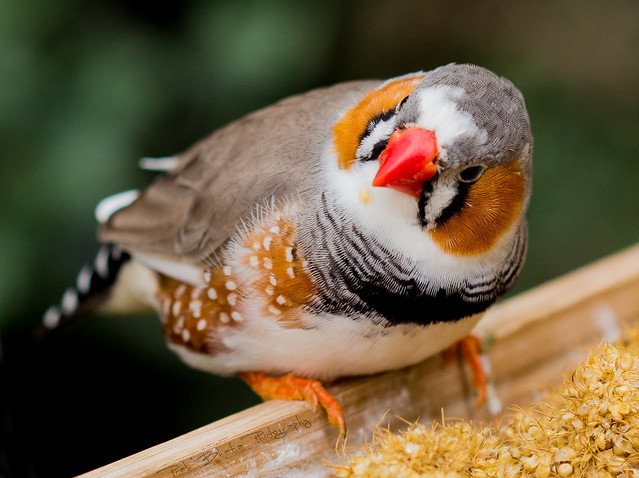(Original Title: Zebra Finches-Fiesty Birds With a Perky Attitude!)
 |
| Photo by Prab Bhatia Photography |
Introduction
Zebra finches are classified as the smallest of the pet birds available on the market. Originating from the continent of Australia, they are also found in Indonesia, Central, and North America. With their attractive plumage and ease of maintenance, they are highly prized as pets. They are relatively hardy birds which can be kept indoors as well as in outdoor aviaries.
They have been a popular pet bird for over 100 years. They are an ideal choice for any bird enthusiast or anyone looking for a pet. Zebra Finches can live up to 10 years with good nutrition and care.
Description
Zebra finches come in several patterns and colors. They vary in color according to their breed. Typically, the male sports a gray-hued body and wings, while his underside is off-white. The beak and legs are a red-orange color. There are cheek patches on his head and a tear-dropped shaped mark under the eyes. There is a chestnut brown white dotted coloration below the wings. And finally, the male has a black and white striped chest which gives the species its' common name.
The female boasts a gray-hued body and wings along with the off-white underside. The beak is one shade of orange lighter than that of the male. The major difference in appearance between male and female is that the male displays the cheek patches while the female does not. Both females and males have red eyes and their feet are a combination of orange and yellow.
Behavior
Zebra finches are active birds, able to entertain themselves. They have soft, pleasing vocalizations consisting of chirping and peeping. They are flock birds and do best when a number of pairs are housed together. They are usually sold in pairs and need to be maintained as pairs for their emotional well-being.
Zebra finches are messy and voracious eaters, typically dropping seed everywhere. They are feisty little critters with a perky attitude. Zebra finches are crazy about canary tassel toys!
Like all finches, Zebra finches are cautious with humans and don't enjoy being touched. These birds do not become finger tame, though they do come to enjoy the interaction with their owners over time. However, some owners attest to bird's ability to learn to become at ease with a human touch. As social animals, they do require the company of other compatible birds to stay emotionally healthy.
Cages and Aviaries
Zebra finches are relatively hardy birds that can be kept indoors, or in outdoor aviaries. Experts advise owners to house their finches in the largest cage affordable. Zebra finches do well in a mixed aviary. However, they don't mix well with all species of finches.
Feeding
All finches are mostly seed eaters. Finch owners have assumed that their birds need grit similar to other bird species. However, finches do not require grit. Give your birds daily fresh water. Finches can die within 24 hours without water. Supplement their diet of seeds with greens and fruit-but don't overdo it! Supply a calcium supplement, especially during mating season. Cooked eggshells make a good substitute for cuttlebone.
Health
Zebra finches are usually quite healthy, but not quite as hardy as larger pet birds,
They are very susceptible to airborne toxins. Also, they can catch colds from drafts. Therefore, they need to be housed clear of windows and doors in order to stay healthy. They will do well in temperatures down to around 40 F.
Breeding
Zebra finches easily breed in captivity. Zebras breed colonially and are socially monogamous, in many cases maintaining permanent pair bonds. The male helps in the nest building as well as hatching duties and feeding the young. Zebra finches can lay a maximum of eight eggs, but usually have 2 to 5 eggs in their nests. Zebra Finches will lay one egg every other day until their clutch is complete.
After egg laying, it's the hen that will spend most of her time on the nest. The male will from time to time, relieve her for food and exercise breaks. The eggs will begin to hatch 12 to 18 days after they have been laid.
Breeding zebra finches in pair cages are ideal. However, they will breed in aviaries. During mating season the birds require up to 16 hours of daily sunlight. If there is no window in the area where the cage is located, supply an artificial source of light with a timer.
Conclusion
Zebra finches are arguably the most popular and commonly kept Australian finch species. Zebra finches are some of the easiest pet birds to keep and can make excellent companions for people where noise and space is a concern. With good nutrition and care, these birds can live up to 10 years. They are considered one of my favorite of all finch varieties.
Daniel P. Ransom is a finch expert. He has been raising and breeding many varieties of finches for over 20 years. He supplies local and regional pet shops with happy and healthy birds. Article Source: EzineArticles |

No comments:
Post a Comment